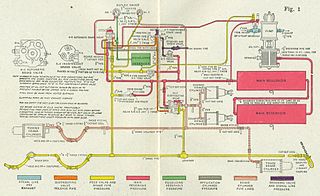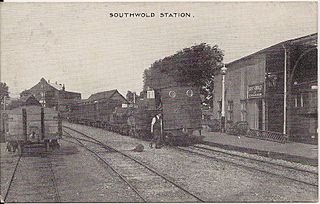
High Speed 1 (HS1), legally the Channel Tunnel Rail Link (CTRL), is a 109.9-kilometre (68.3-mile) high-speed railway linking London with the Channel Tunnel.

A railway air brake is a railway brake power braking system with compressed air as the operating medium. Modern trains rely upon a fail-safe air brake system that is based upon a design patented by George Westinghouse on April 13, 1869. The Westinghouse Air Brake Company was subsequently organized to manufacture and sell Westinghouse's invention. In various forms, it has been nearly universally adopted.
The Armagh rail disaster happened on 12 June 1889 near Armagh, County Armagh, in Ireland, when a crowded Sunday school excursion train had to negotiate a steep incline; the steam locomotive was unable to complete the climb and the train stalled. The train crew decided to divide the train and take forward the front portion, leaving the rear portion on the running line. The rear portion was inadequately braked and ran back down the gradient, colliding with a following train.

On trains, the expression emergency brake has several meanings:

The Light Railways Act 1896 was an act of the Parliament of the United Kingdom of Great Britain and Ireland.
The Potteries, Shrewsbury and North Wales Railway,, was a railway built between Shrewsbury, England, and quarry locations at Nantmawr and Criggion in Wales. It was initially opened in 1866; despite the extensive title it never reached further than those extremities. It had cost about £1.5 million to construct, but its financial performance was extremely poor, and economies resulted in near-suspension of maintenance, leading to dangerous conditions. The line rapidly became very run down as a result of low revenues and poor maintenance, and was closed at the instigation of the Board of Trade for safety reasons in June 1880. It lay derelict for 30 years but was revived when the Shropshire and Montgomeryshire Railway re-opened it as a light railway in 1911.

The Regulation of Railways Act 1889 is an Act of the Parliament of the United Kingdom. It is one of the Railway Regulation Acts 1840 to 1893. It was enacted following the Armagh rail disaster.

The Civil Contingencies Act 2004 (c. 36) is an act of the Parliament of the United Kingdom that makes provision about civil contingencies. It also replaces former civil defence and emergency powers legislation of the 20th century.

The Railways Act 2005 is an act of the Parliament of the United Kingdom concerning the regulatory structure for railways in the United Kingdom.

The Southwold Railway was a narrow gauge railway line between Halesworth and Southwold in the English county of Suffolk. 8 miles 63+1⁄2 chains (14.15 km) long, it was 3 ft narrow gauge. It opened in 1879 and closed in 1929.
The Portpatrick and Wigtownshire Joint Railways was a network of railway lines serving sparsely populated areas of south-west Scotland. The title appeared in 1885 when the previously independent Portpatrick Railway (PPR) and Wigtownshire Railway (WR) companies were amalgamated by Act of Parliament into a new company jointly owned by the Caledonian Railway, Glasgow & South Western Railway, Midland Railway and the London & North Western Railway and managed by a committee called the Portpatrick and Wigtownshire Joint Committee.

Franz Müller, was a German tailor who was hanged for the murder of Thomas Briggs, the first killing on a British train. The case caught the imagination of the public due to increasing safety fears about rail travel at the time and the pursuit of Müller across the Atlantic Ocean to New York City by Scotland Yard.
The North Devon Railway connected Barnstaple to the growing railway network in 1854 and as Ilfracombe developed as a watering place, it was obvious a railway connection to the town was needed. The hilly terrain was very difficult, but an Ilfracombe Railway was authorised in 1864 but failed when a major shareholder was unable to respond to a subscription call. After several false starts the Barnstaple and Ilfracombe Railway, soon taken over by the London and South Western Railway, opened in 1870.

The Railway Regulation Act 1844 was an act of the Parliament of the United Kingdom providing a minimum standard for rail passenger travel. It provided compulsory services at a price affordable to poorer people to enable them to travel to find work. It is one of the Railway Regulation Acts 1840 to 1893.
The Stonehouse and Nailsworth Railway was a short railway line in the county of Gloucestershire, England. It was promoted independently to connect the industrial town of Nailsworth to the main line railway network at Stonehouse. It opened in 1867, but was immediately in financial difficulty, due largely to debenture interest payments and other financial commitments from the construction.

The Rail Safety Act 2006 is a law enacted by the Parliament of the State of Victoria, Australia, and is the prime statute regulating the safety of rail operations in Victoria. The Act was developed as part of the Transport Legislation Review conducted by the Department of Transport between 2004 and 2010 and is aimed at preventing deaths and injuries arising from rail operations.
Rail regulations in Canada are set by Transport Canada and the Canadian Transportation Agency. The 2007 "Railway Safety Act Review" was commissioned by the Minister of Transport and its report provides much-needed background to this article, especially section 4.3. The governance of railways in Canada is complex and has many tiers: Acts of Parliament, Regulations, Rules, and Directives are only some of the instruments that impact this industry.
The Carmyllie Railway was built in 1855 to enable transport of stone products from the Carmyllie area of Scotland to markets. At the time the stone was highly sought after for the urban development in progress.

There are around 6,000 level crossings in the United Kingdom, of which about 1,500 are public highway crossings. This number is gradually being reduced as the risk of accidents at level crossings is considered high. The director of the UK Railway Inspectorate commented in 2004 that "the use of level crossings contributes the greatest potential for catastrophic risk on the railways." The creation of new level crossings on the national network is banned, with bridges and tunnels being the more favoured options. The cost of making significant reductions, other than by simply closing the crossings, is substantial; some commentators argue that the money could be better spent. Some 5,000 crossings are user-worked crossings or footpaths with very low usage. The removal of crossings can improve train performance and lower accident rates, as some crossings have low rail speed limits enforced on them to protect road users. In fact, between 1845 and 1933, there was a 4 miles per hour (6.4 km/h) speed limit on level crossings of turnpike roads adjacent to stations for lines whose authorising act of Parliament had been consolidated in the Railways Clauses Consolidation Act 1845 although this limit was at least sometimes disregarded.

The Coronavirus Act 2020 is an act of the Parliament of the United Kingdom that granted the government emergency powers to handle the COVID-19 pandemic. The act allowed the government the discretionary power to limit or suspend public gatherings, to detain individuals suspected to be infected by COVID-19, and to intervene or relax regulations in a range of sectors to limit transmission of the disease, ease the burden on public health services, and assist healthcare workers and the economically affected. Areas covered by the act included the National Health Service, social care, schools, police, Border Force, local councils, funerals and courts. The act was introduced to Parliament on 19 March 2020, and passed the House of Commons without a vote on 23 March, and the House of Lords on 25 March. The act received royal assent on 25 March 2020.









